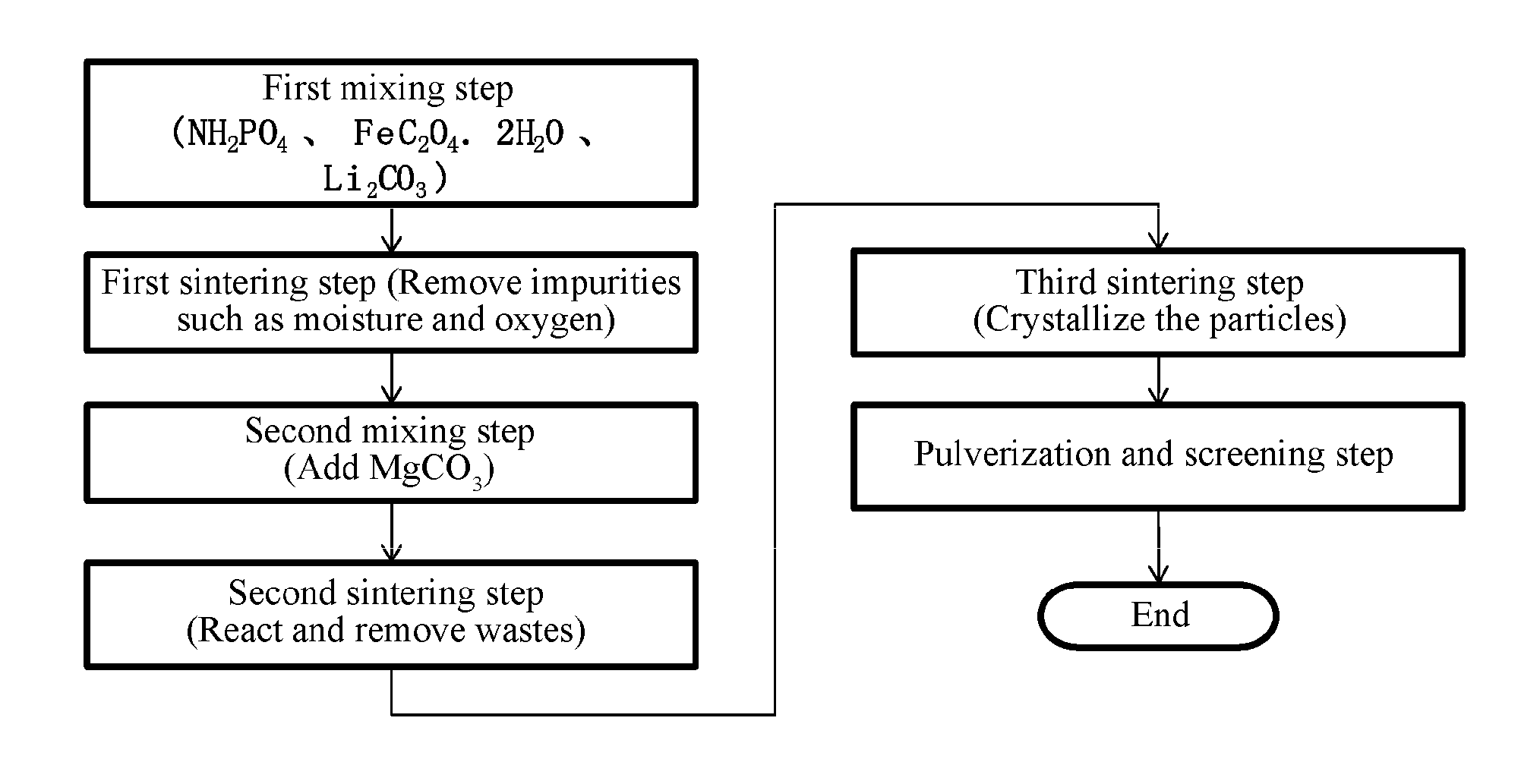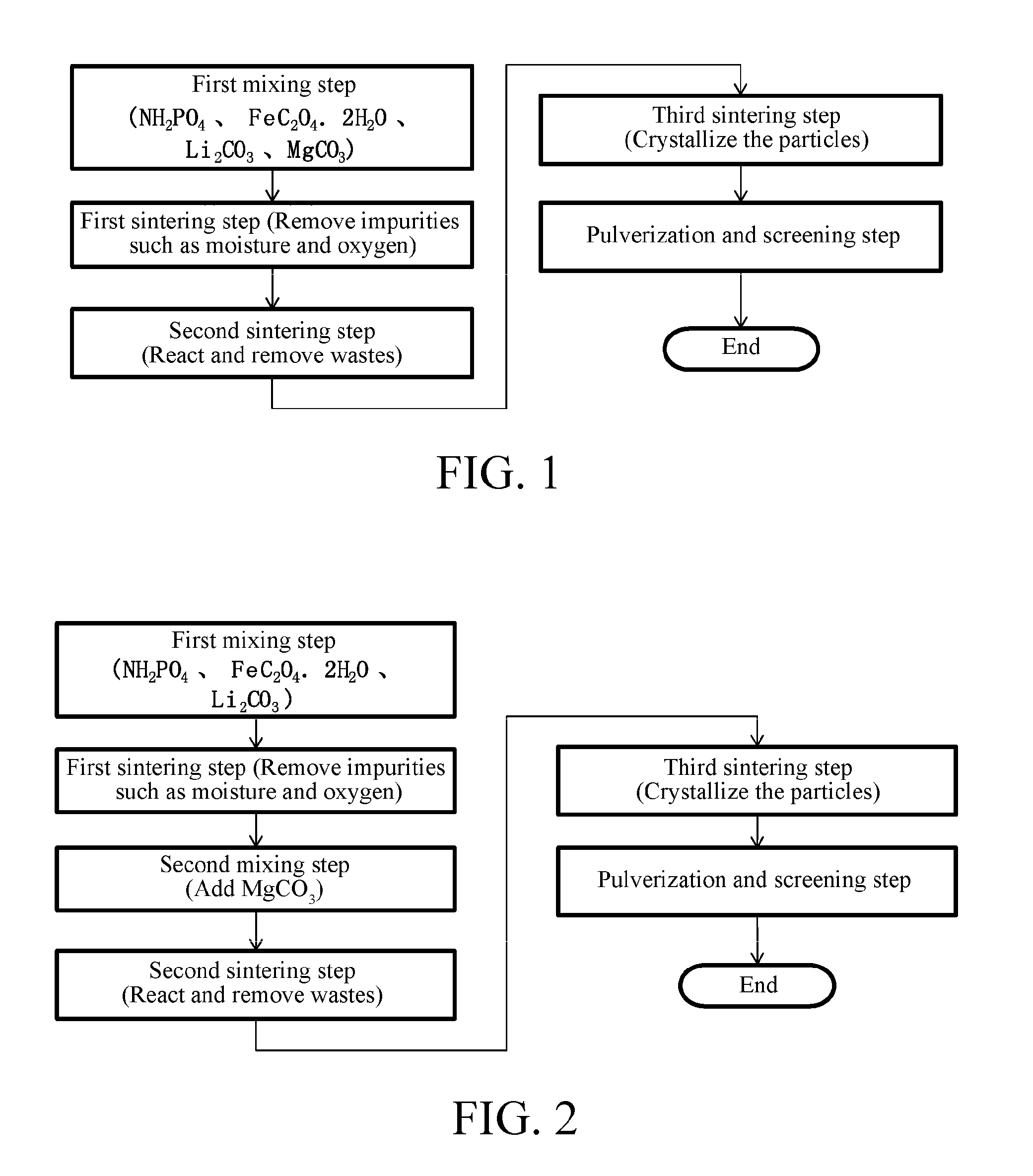Cathode material usable for batteries and method of making same
a cathode material and battery technology, applied in the direction of phosphates, phosphorus oxyacids, cell components, etc., can solve the problems of unaddressed need in the ar
- Summary
- Abstract
- Description
- Claims
- Application Information
AI Technical Summary
Benefits of technology
Problems solved by technology
Method used
Image
Examples
example 1
Preparation Method with Addition of Magnesium Carbonate and Sintering in Absence of Vacuum
[0030]1.1 Raw materials:
[0031]1.1.1 Aminophosphate (NH2PO4), 39.8 g,
[0032]1.1.2 Ferrous oxalate (FeC2O4), 97.5 g,
[0033]1.1.3 Lithium carbonate (Li2CO3), 8.0 g, and
[0034]1.1.4 Magnesium carbonate (MgCO3), 0.4 g.
[0035]1.2 Preparation method: an embodiment with addition of an intermediate destroyer (as shown in FIG. 2).
[0036]1.2.1 First mixing step: aminophosphate, ferrous oxalate, lithium carbonate, and magnesium carbonate described in Section 1.1 were mixed, and milled to form a powder with uniform particle size.
[0037]1.2.2 First sintering step: the raw materials obtained in Step 1.2.1 were heated at 250° C. for 2 hours under the protection of nitrogen, and the liquid and gaseous impurities generated in the sintering process were separated by refreshing nitrogen every 30 minutes.
[0038]1.2.3 Second sintering step: the product obtained in Step 1.2.2 was sintered at 500° C. for 2 hours under the pr...
example 2
Preparation Method without Addition of Magnesium Carbonate, and with Sintering Under Vacuum
[0042]2.1 Raw materials:
[0043]2.1.1 Aminophosphate (NH2PO4), 39.8 g,
[0044]2.1.2 Ferrous oxalate (FeC2O4), 97.5 g, and
[0045]2.1.3 Lithium carbonate (Li2CO3), 8.0 g.
[0046]2.2 Preparation method: an embodiment with sintering under vacuum (as shown in FIG. 1).
[0047]2.2.1 First mixing step: aminophosphate, ferrous oxalate, and lithium carbonate described in Section 2.1 were mixed and milled to form a powder with uniform particle size.
[0048]2.2.2 First sintering step: the raw materials obtained in Step 2.2.1 were heated at 250° C. for 2 hours in a vacuum environment, the liquid and gaseous impurities generated in the sintering process were separated, and oxalic acid and carbonic acid were removed, while phosphoric acid was kept.
[0049]2.2.3 Second sintering step: the product obtained in Step 2.2.2 was sintered at 500° C. for 2 hours in a vacuum environment, and the generated carbon dioxide (CO2), amm...
example 3
Preparation Method with Addition of Magnesium Carbonate and Sintering in Absence of Vacuum
[0053]3.1 Raw materials:
[0054]3.1.1 Aminophosphate (NH2PO4), 39.8 g,
[0055]3.1.2 Ferrous oxalate (FeC2O4), 97.5 g,
[0056]3.1.3 Lithium carbonate (Li2CO3), 8.0 g, and
[0057]3.1.4 Magnesium carbonate (MgCO3), 0.5 g.
[0058]3.2 Preparation method: an embodiment with addition of an intermediate destroyer (as shown in FIG. 2).
[0059]3.2.1 First mixing step: aminophosphate, ferrous oxalate, and lithium carbonate described in Section 3.1 were mixed, and milled to form a powder with uniform particle size.
[0060]3.2.2 First sintering step: the raw materials obtained in Step 3.2.1 were heated at 300° C. for 2 hours under the protection of nitrogen, and the liquid and gaseous impurities generated in the sintering process were separated by refreshing nitrogen every 30 minutes.
[0061]3.2.3 Second mixing step: the product obtained in Step 3.2.2 was mixed with magnesium carbonate, and milled into a uniform power mixt...
PUM
| Property | Measurement | Unit |
|---|---|---|
| temperature | aaaaa | aaaaa |
| temperature | aaaaa | aaaaa |
| temperature | aaaaa | aaaaa |
Abstract
Description
Claims
Application Information
 Login to View More
Login to View More - R&D
- Intellectual Property
- Life Sciences
- Materials
- Tech Scout
- Unparalleled Data Quality
- Higher Quality Content
- 60% Fewer Hallucinations
Browse by: Latest US Patents, China's latest patents, Technical Efficacy Thesaurus, Application Domain, Technology Topic, Popular Technical Reports.
© 2025 PatSnap. All rights reserved.Legal|Privacy policy|Modern Slavery Act Transparency Statement|Sitemap|About US| Contact US: help@patsnap.com


